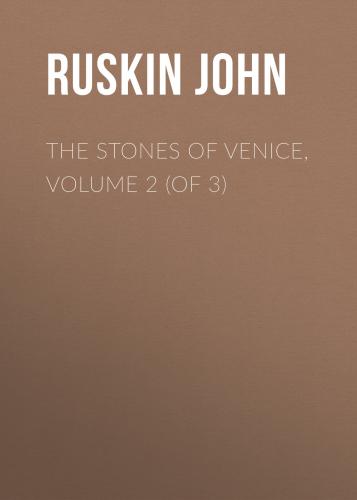§ XLIX. It is left a fragment, in order to get it on a larger scale; and yet even on this scale it is too small to show the sharp folds and points of the marble vine-leaves with sufficient clearness. The ground of it is gold, the sculpture in the spandrils is not more than an inch and a half deep, rarely so much. It is in fact nothing more than an exquisite sketching of outlines in marble, to about the same depth as in the Elgin frieze; the draperies, however, being filled with close folds, in the manner of the Byzantine pictures, folds especially necessary here, as large masses could not be expressed in the shallow sculpture without becoming insipid; but the disposition of these folds is always most beautiful, and often opposed by broad and simple spaces, like that obtained by the scroll in the hand of the prophet, seen in the plate.
VI.
THE VINE TREE, AND IN SERVICE.
The balls in the archivolt project considerably, and the interstices between their interwoven bands of marble are filled with colors like the illuminations of a manuscript; violet, crimson, blue, gold, and green alternately: but no green is ever used without an intermixture of blue pieces in the mosaic, nor any blue without a little centre of pale green; sometimes only a single piece of glass a quarter of an inch square, so subtle was the feeling for color which was thus to be satisfied.32 The intermediate circles have golden stars set on an azure ground, varied in the same manner; and the small crosses seen in the intervals are alternately blue and subdued scarlet, with two small circles of white set in the golden ground above and beneath them, each only about half an inch across (this work, remember, being on the outside of the building, and twenty feet above the eye), while the blue crosses have each a pale green centre. Of all this exquisitely mingled hue, no plate, however large or expensive, could give any adequate conception; but, if the reader will supply in imagination to the engraving what he supplies to a common woodcut of a group of flowers, the decision of the respective merits of modern and of Byzantine architecture may be allowed to rest on this fragment of St. Mark’s alone.
Конец ознакомительного фрагмента.
Текст предоставлен ООО «ЛитРес».
Прочитайте эту книгу целиком, купив полную легальную версию на ЛитРес.
Безопасно оплатить книгу можно банковской картой Visa, MasterCard, Maestro, со счета мобильного телефона, с платежного терминала, в салоне МТС или Связной, через PayPal, WebMoney, Яндекс.Деньги, QIWI Кошелек, бонусными картами или другим удобным Вам способом.
